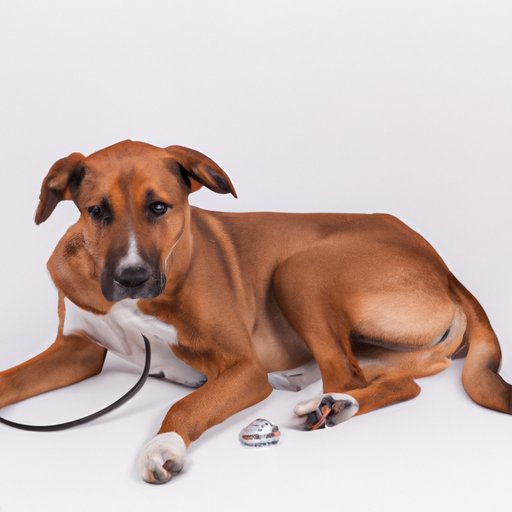
I. Introduction
Fleas are a common problem for dog owners worldwide, and if left untreated, they can cause painful itching, allergic reactions, and even serious health issues. This article aims to provide a comprehensive guide to help dog owners identify if their canine companion has fleas, and what steps they can take to treat and prevent further infestations.
II. The Ultimate Guide to Identifying Fleas on Your Dog
Flea infestations on dogs can be tricky to spot, especially in the early stages. One sign to look out for is excessive scratching, biting, and licking of the skin. Red or irritated skin, scabs, and hair loss are also telltale signs of fleas on dogs.
Fleas have a life cycle of approximately three weeks and can spread quickly from pet to pet or environment. Adult fleas typically feed on the host (dog) and lay eggs on the fur, which then drop off and develop into larvae in the surrounding environment. The larvae then mature into adult fleas, and the cycle continues.
To help diagnose flea infestations, dog owners can use a flea comb to check for live fleas and flea dirt (flea feces), which looks like black pepper. It’s important to take preventative measures and treat flea infestations as soon as possible to avoid severe skin damage or anemia.
III. 5 Signs Your Dog Might Have Fleas (And What to Do About It)
The most common symptoms of flea infestations in dogs are:
- Excessive Scratching and Chewing
- Red or Irritated Skin
- Visible Fleas or Flea Dirt
- Hair Loss or Bald Spots
- Anemia (in severe cases)
These symptoms occur due to a dog’s allergic reaction to flea bites, and the skin’s response to flea saliva. To treat flea infestations, dog owners should use flea medication (usually prescribed by their veterinarian), regularly vacuum the home, and wash all bedding and fabrics that may have come into contact with fleas.
Preventative measures such as flea collars, flea sprays, and monthly flea treatments can also help keep flea infestations at bay.
IV. The Top 3 Ways to Naturally Treat Fleas on Your Dog
Natural remedies can be effective in alleviating a dog’s discomfort due to fleas. Still, it’s crucial to consult with a veterinarian before administering any home remedies, as some plants or essential oils may be toxic to dogs.
Three natural remedies for treating fleas on dogs are:
- Essential Oils: Cedarwood, lavender, and lemongrass essential oils are known to repel fleas naturally. Mix a few drops of essential oil with a carrier oil (such as coconut oil) and apply to your dog’s coat. Do not use essential oils directly on your dog’s skin.
- Vinegar: Mix equal parts vinegar and water in a spray bottle and apply to your dog’s coat. Focus on the areas where fleas are most likely present.
- Diatomaceous Earth: This powdery substance can be sprinkled on carpets and fabrics to kill fleas in their tracks. Be careful not to inhale the dust, and keep your dog away from treated areas until the dust has settled.
Home remedies like using garlic or onion can actually cause harm to dogs, so it’s essential to research these remedies carefully before trying them on your pet.
V. What To Do If You Can’t Get Rid of Your Dog’s Fleas
If traditional flea treatments aren’t working, it’s best to seek the advice of a veterinarian. Fleas can develop resistance to certain flea medication, and in severe cases, the infestation may require professional pest control services to eradicate.
Alternative flea treatment options include:
- Flea Shampoos: A medicated shampoo specifically designed to treat fleas can help soothe a dog’s skin and kill fleas on their coat. Be sure to check with your veterinarian before using flea shampoos, as some breeds may be sensitive to certain ingredients.
- Flea Collars: Flea collars can be effective in preventing flea infestations, but they may not work for severe infestations. Be sure to choose a collar that is safe for your dog and consult with your veterinarian before use.
- Professional Pest Control Services: Pest control services can help eradicate severe flea infestations in your home and provide strategies for preventing future infestations.
VI. Flea Prevention 101: Tips for Keeping Your Dog Healthy and Pest-Free
The best way to deal with fleas is to prevent them from becoming a problem in the first place. Regular grooming habits, like brushing and bathing your dog, can help keep their coat healthy and flea-free.
Additional flea prevention strategies include:
- Regularly vacuum carpets and upholstery and wash bedding and fabrics that your dog has come into contact with.
- Use flea medication as prescribed by your veterinarian.
- Keep your yard and outdoor areas clean, mowed, and free of debris to discourage flea habitats.
- Consider adding dietary supplements like omega-3 fatty acids to your dog’s diet to strengthen their immune system against pests.
VII. Conclusion
Identifying and treating flea infestations on dogs can be a frustrating and challenging task for pet owners. However, with the right information and preventative measures, flea infestations can be managed and prevented.
Remember to consult with your veterinarian before using any flea medications or home remedies, and stay on top of regular grooming and flea prevention habits to keep your furry friend happy, healthy, and pest-free.





